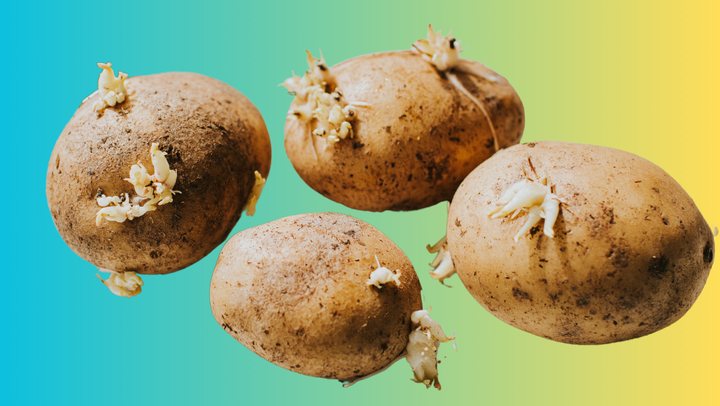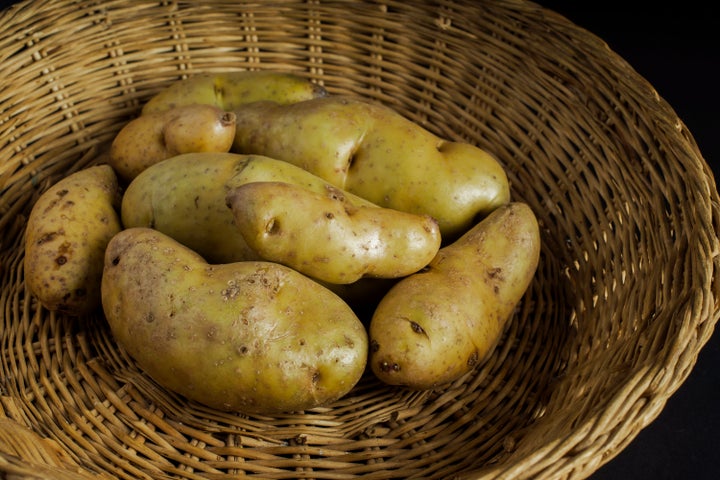
If tomato season is the highlight of summer, potato season is the highlight of fall and winter. As we stock up on flavourful sweet potatoes for fall dinners and russet potatoes for Thanksgiving sides, one big question lingers for potato lovers everywhere: Is it safe to eat potatoes once they start looking kind of ... weird?
If a potato has ever sat on your countertop or in your pantry for a while, you know what we’re talking about – a greenish tint and little buds called eyes that were definitely the inspiration for the Mr Potato Head toy. They look weird, sure, but it’s common knowledge in 2023 that “ugly produce” is still OK to eat and eliminates food waste. So once potatoes start looking a little worse for the wear, is the same thing true? Are ugly potatoes OK to eat?
Not exactly.
We asked food safety experts and registered dieticians for the scoop on what it really means when potatoes start sprouting eyes and turning green. Here’s what they had to say (and why potatoes in general are still a very good idea to eat).
Here’s the truth about potatoes with eyes
First, the good news. Once potatoes start to sprout eyes, they are still generally safe to eat as long as the sprouting isn’t out of control.
“These sprouts contain a toxin called solanine, which can cause illness such as headache, vomiting and other digestive symptoms,” explained Ellen Shumaker, director of outreach and extension for Safe Plates at North Carolina State University.
“If large amounts of it are consumed it can cause quite serious symptoms. But if sprouts are small and the potato is not soft or shrivelled, the sprouts can be cut off and the potato can be eaten.”
What about green potatoes?
Fried green tomatoes may be a delicacy, but fried green potatoes are not. “Don’t eat these!” warned Maggie Michalczyk, a registered dietitian and founder of Once Upon a Pumpkin. “Sunlight turns potatoes green as they produce chlorophyll, but the real issue is the build-up of harmful toxins.”
Shumaker echoed this. “Seeing green on potatoes indicates the formation of the toxin solanine, also found in the sprouts,” she said. “If there are small green spots on a potato, they can be trimmed off but if they are large green spots, it is recommended that you discard the potato.”
Eyes and a greenish tint are the main signs that a potato has gone bad or is starting to go bad, Shumaker said. And if a potato is shrivelled and soft, that’s definitely a sign that you should throw it out. Not convinced? While the effects of consuming bad potatoes are mostly gastrointestinal, in severe cases, solanine can actually cause paralysis.
Green potatoes with eyes aren’t exactly a nutritional powerhouse, either
In general, it’s best to steer clear of funny-looking potatoes, especially if they’ve started turning green. But once potatoes have started showing symptoms of greenness, tubers and sprouts, they’ll also develop a bitter taste. They likely won’t contain as many nutrients, either.

“While there hasn’t been much research on this topic, we can assume that the nutrient content of sprouted potatoes is less than that of non-sprouted potatoes because they are exposed to more oxidation from higher temperatures,” said Tamar Samuels, registered dietitian and co-founder of Culina Health.
With that in mind, if you’re dealing with a normal-looking potato — whether it’s a sweet potato or a white potato — you can rest assured that you’re getting tons of essential vitamins and minerals in every bite. “You can feel good knowing both types of potatoes are nutritious,” Michalczyk said. “White potatoes contain vitamin C, and potassium and sweet potatoes are a great source of vitamin A thanks to their orange color.”
In fact, potatoes literally saved lives in early times because their high vitamin C content helped prevent scurvy. So don’t let the fear of solanine deter your potato consumption — just try to keep your potatoes fresh by storing them in a cool, dry place or even in a paper bag to protect them from the sun. And if your potatoes do start to turn green, steer clear of them.
With all that in mind, get ready to mash up some potatoes and enjoy every bite.